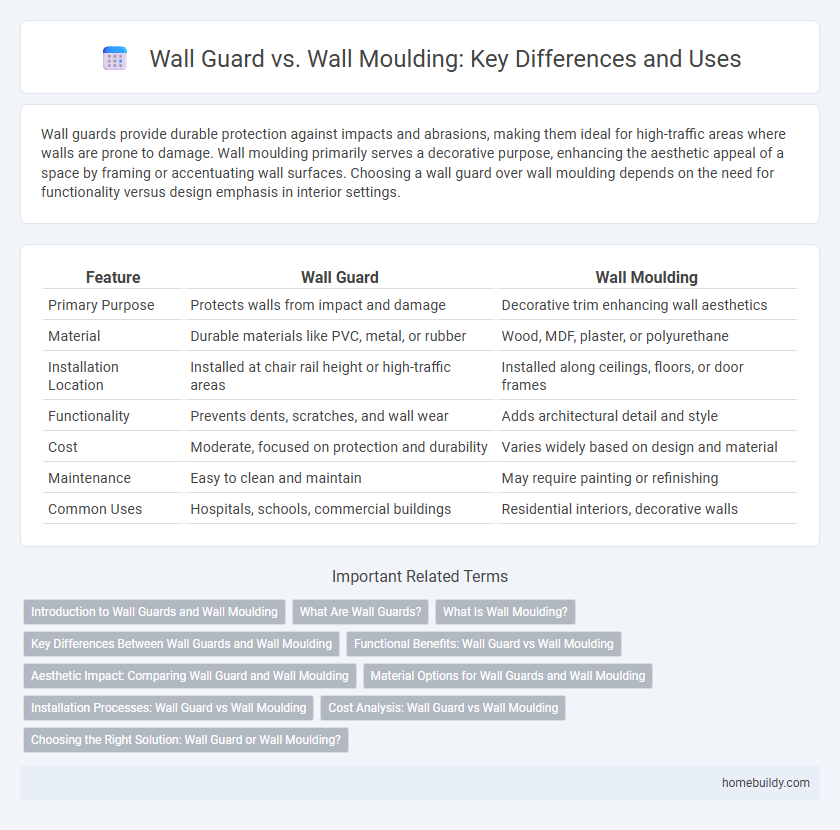Wall guards provide durable protection against impacts and abrasions, making them ideal for high-traffic areas where walls are prone to damage. Wall moulding primarily serves a decorative purpose, enhancing the aesthetic appeal of a space by framing or accentuating wall surfaces. Choosing a wall guard over wall moulding depends on the need for functionality versus design emphasis in interior settings.
Table of Comparison
| Feature | Wall Guard | Wall Moulding |
|---|---|---|
| Primary Purpose | Protects walls from impact and damage | Decorative trim enhancing wall aesthetics |
| Material | Durable materials like PVC, metal, or rubber | Wood, MDF, plaster, or polyurethane |
| Installation Location | Installed at chair rail height or high-traffic areas | Installed along ceilings, floors, or door frames |
| Functionality | Prevents dents, scratches, and wall wear | Adds architectural detail and style |
| Cost | Moderate, focused on protection and durability | Varies widely based on design and material |
| Maintenance | Easy to clean and maintain | May require painting or refinishing |
| Common Uses | Hospitals, schools, commercial buildings | Residential interiors, decorative walls |
Introduction to Wall Guards and Wall Moulding
Wall guards provide durable protection to walls against impacts and damage in high-traffic areas, commonly used in commercial spaces like hospitals and schools. Wall moulding, also known as chair rail or decorative moulding, primarily enhances the aesthetic appeal of walls while offering moderate protection against scuffs and dents. Both wall guards and wall mouldings serve different functional and decorative purposes, making them essential considerations in interior wall management.
What Are Wall Guards?
Wall guards are protective panels installed on walls to prevent damage from impact, commonly found in high-traffic areas like hospitals and commercial buildings. Unlike wall mouldings, which primarily serve decorative purposes and may define wall edges or transitions, wall guards are designed with durability and resistance to dents and scratches. Materials for wall guards often include vinyl, rubber, or metal, providing a functional barrier that maintains wall integrity over time.
What Is Wall Moulding?
Wall moulding refers to decorative strips or panels applied to interior walls to enhance aesthetic appeal and add architectural interest. Unlike wall guards, which primarily protect walls from damage in high-traffic areas, wall mouldings serve a decorative purpose, often featuring intricate designs and profiles. Common types of wall moulding include chair rails, wainscoting, and crown moulding, each contributing to a room's visual style and character.
Key Differences Between Wall Guards and Wall Moulding
Wall guards are primarily designed to protect walls from damage due to impact, commonly used in high-traffic areas such as hospitals and commercial buildings, whereas wall moulding serves decorative purposes, enhancing the aesthetic appeal of interior spaces. Wall guards are typically made from durable materials like vinyl or rubber to withstand heavy use, while wall mouldings are often crafted from wood, MDF, or polyurethane to achieve intricate designs. The installation of wall guards focuses on functionality and durability, contrasting with the installation of wall mouldings, which emphasizes visual detail and architectural style.
Functional Benefits: Wall Guard vs Wall Moulding
Wall guards provide superior impact resistance and protection against damage in high-traffic areas, making them ideal for hospitals and commercial spaces. Wall mouldings primarily offer decorative enhancement and minor edge protection but lack the robust durability of wall guards. Choosing wall guards over mouldings ensures long-term maintenance savings by preventing wall damage and reducing repair frequency.
Aesthetic Impact: Comparing Wall Guard and Wall Moulding
Wall guards offer a sleek, functional protection with minimal visual interruption, maintaining clean wall lines while preventing damage in high-traffic areas. Wall moulding provides decorative appeal through various profiles and materials, enhancing room character with intricate designs but may draw attention away from minimalist interiors. Choosing between wall guard and wall moulding depends on balancing durable protection with desired stylistic enhancement for interior spaces.
Material Options for Wall Guards and Wall Moulding
Wall guards are typically made from durable materials like PVC, vinyl, rubber, and aluminum to provide impact resistance and protection in high-traffic areas, while wall moulding often uses wood, MDF, or polyurethane for decorative finishes. PVC and rubber wall guards offer flexibility and easy maintenance, ideal for commercial spaces, whereas wood and MDF mouldings emphasize aesthetic appeal and customization. Aluminum wall guards provide robust durability and corrosion resistance, contrasting with polyurethane mouldings that balance lightweight design and decorative versatility.
Installation Processes: Wall Guard vs Wall Moulding
Wall guard installation involves securely mounting robust, impact-resistant strips directly onto walls, typically using adhesive or mechanical fasteners to protect high-traffic areas from damage. Wall moulding installation requires precise measurement, cutting, and often nailing or gluing decorative trim along wall edges or transitions, focusing primarily on aesthetic enhancement and minor protection. The installation of wall guards prioritizes durability and functional protection, while wall moulding emphasizes decorative alignment and seamless integration with interior design elements.
Cost Analysis: Wall Guard vs Wall Moulding
Wall guards typically cost between $10 to $30 per linear foot, offering durable protection against impact and wear, making them a cost-effective solution for high-traffic areas. Wall mouldings range from $5 to $25 per linear foot but usually provide only aesthetic enhancement without significant protection, which may result in higher maintenance expenses over time. Investing in wall guards minimizes repair costs and extends wall longevity, whereas wall mouldings might require more frequent replacement or touch-ups.
Choosing the Right Solution: Wall Guard or Wall Moulding?
Wall guards provide robust protection against impact damage in high-traffic areas, making them ideal for commercial and healthcare environments. Wall mouldings offer decorative finishes that conceal imperfections while providing moderate protection, suited for residential or office spaces. Selecting between wall guards and wall mouldings depends on the level of durability required and the desired aesthetic impact.
Wall guard vs Wall moulding Infographic

 homebuildy.com
homebuildy.com